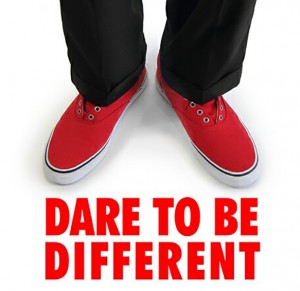 There’s a traditional Japanese proverb that says “The nail that stands out is quickly hammered down.” For generations, conformity has been a societal standard in Japan.
There’s a traditional Japanese proverb that says “The nail that stands out is quickly hammered down.” For generations, conformity has been a societal standard in Japan.
The funny thing is, it’s not that different in American business. More companies, large and small, are comfortable looking like all the others and doing things the way they’ve always been done. Breaking away from tradition is something one dare not do for risk of offending someone, or making the folks in the back offices uncomfortable.
To that, I say, Poppycock, balderdash, bull-pucky!
Every once in a great while, I’ll see some marketing effort that is truly exceptional, even edgy – and I’ll contact the marketer and ask about the results. Almost all tell me that the effort was successful and helped them stand out in their marketplace.
Do they get complaints? Yes, some…but mostly they get new business, so it’s worth the risk. And this has also been our experience. When an advertiser Dares to be Different, they get noticed, and sales commonly start to follow. Which is why our own motto, Dare to be Different, has been on our lips since we began in the 1990s.
And the funny thing is, it doesn’t take much to be different and get noticed.
Take our Red Shoes, which we always wear to conventions. You might say it’s our walking trademark, but really, it’s just our putting our own philosophy where our feet are.
People we’ve never met, never spoken with, stop us as we walk down the aisles wanting to know about our red shoes. When we walk along the booths, we’re always noticing how people’s eyes suddenly dart downward to our shoes and they smile. Friends will see us all the way across the hall because our red shoes stand out, even in a crowd. We even had one guy tell us, “I’ve now seen you walking down this aisle four times – but I never noticed anyone else!”
All this from just wearing a pair of red shoes. What does that tell you?
Different is visible. Different is memorable. Different is interesting.
So, the question is… will you Dare to be Different to capture attention and get new business? Or is your own comfort zone holding you back? As I always like to say, if you don’t know the answer to this, your audience certainly does.
####
Dan Katz is president, creative director of LA ads. To discuss your thoughts with Dan on this blog or any marketing matters, email via this link, or visit www.LAadsMarketing.com. You can also connect with Dan on LinkedIn. See agency work via this link.
 Living in Los Angeles, you can’t avoid lengthy commutes, and with lengthy commutes comes lots of opportunities to see billboards. Oh, we’ve got lots of ‘em…of all sizes…pitching everything from auto lube centers to Hollywood blockbusters. Yes, even funeral homes and law firms use this tried-and-true medium, which as it turns out, is a great vehicle (no pun intended) for local advertising. After all, done right, billboards can stand out. If you’re stuck in traffic, you’re a captive audience. They’re a great “reminder” medium supporting other marketing efforts. And they can be located strategically, even across the street from a competitor!
Living in Los Angeles, you can’t avoid lengthy commutes, and with lengthy commutes comes lots of opportunities to see billboards. Oh, we’ve got lots of ‘em…of all sizes…pitching everything from auto lube centers to Hollywood blockbusters. Yes, even funeral homes and law firms use this tried-and-true medium, which as it turns out, is a great vehicle (no pun intended) for local advertising. After all, done right, billboards can stand out. If you’re stuck in traffic, you’re a captive audience. They’re a great “reminder” medium supporting other marketing efforts. And they can be located strategically, even across the street from a competitor!
Outdoor advertising, which includes billboards, bus benches, bus sides, bus shelters, subway panels and even entire sides of buildings, can be hugely effective if the creative is done correctly. That’s the rub, because there’s a whole lot of outdoor that just sucks and the marketers don’t even know it. Their messages are practically invisible, even if positioned at the best intersections of the city.
Yet doing it right isn’t all that difficult as long as one follows some basic guidelines. Here are a few pointers that can lead to much more effective outdoor advertising.
Interestingly, the same pointers also apply to just about any medium that is either small or a quick read, such as online banners, yellow page ads or tee-shirts.
To start with, respect the medium. It’s only big when you’re standing right next to it. But in your car, it’s barely the size of your own thumb when you hold your hand at arm’s length. And at 45 – 65 miles per hour, it’s only in view for about 5 seconds!
So a good way to test your billboard is to print it out on a sheet of paper and stand far enough back so your thumb can block it out. Then look at it for 5 seconds. If you can’t read the message for that tiny amount of time, redesign the artwork so you can. That’s your litmus test.
Focus on one single, simple message. Don’t make the viewer have to work for it. Have one thing you want to say, say it well, say it quickly and say it simply. And the same goes with any photo or artwork. If someone has to figure out the picture in the few seconds they have, it will be a lost cause.
At the same time, don’t bury your product or brand. When all’s said and done, people must know who or what is being advertised. I see plenty of boards that only after I’ve driven past them a number of times do I know who’s the sponsor. If your brand isn’t Coke or Target or MacDonald’s, make the logo or product a major element.
And finally, billboards are a great reminder medium. They’re a great branding medium. But unless you have a really simple vanity phone number or super-simple and memorable URL, don’t rely on your billboards to generate immediate action if someone has to write down a number or website while driving.
In the end, the old K I S S rule applies – keep it simple. But also, don’t forget to make it powerful too.
####
Dan Katz is president, creative director of LA ads. To discuss your thoughts with Dan on this blog or any marketing matters, email via this link, or visit www.LAadsMarketing.com. You can also connect with Dan on LinkedIn. See agency work via this link.
 Whether you love Donald Trump or you hate him, there’s one thing you’ll have to agree on: He broke every rule of presidential politics…and won! The guy has said things, the guy has done things that every pundit said would lose him the election. And he won!!!
Whether you love Donald Trump or you hate him, there’s one thing you’ll have to agree on: He broke every rule of presidential politics…and won! The guy has said things, the guy has done things that every pundit said would lose him the election. And he won!!!
So what’s going on here? What’s the message that a company like yours must take away from the last year and a half?
It’s that all the traditional rules and all the conventional thinking about marketing no longer matter – in fact they might actually work against you. The climate in the country is CHANGE.
IN with bold. IN with audacious. IN with clean sweeps. And OUT with the Status Quo!
We’ve all heard the phrase, maybe within your organization or department, “That’s not the way we do it here.” In the case of now-President Trump, he certainly didn’t buy into that line. This phrase is used to defend against change. It’s the easy way of avoiding having to change or embrace better alternatives. But the problem with defending “the way we’ve always done it” is it keeps us from doing something new. It keeps us from having to change.
Change forces us to take a position. Taking positions expose us to potential criticism and critique and that makes us uncomfortable. So, to keep from being criticized and being uncomfortable we do the “same old stuff.” But Trump has changed all that. The new rules in this post-election world are: Dare to go on the offensive. Dare to do things differently. Dare to look forward. Dare to be audacious. Dare to risk failure.
In fact, Donald Trump stole a line right out of our hymn book: “Dare to be Different,” and now he’s sitting in the oval office. The Status Quo is over, whether you like it or not. And if you’re not ready to change, well, ask Hilary Clinton how it feels to be on the outside of the White House looking in.
The rules are being re-written even as we speak. So I’m breaking one of my own and putting our agency pitch video right here at the end – because it’s all about change.
I’m Rolf Gutknecht and I approve this message!
Rolf Gutknecht is vice president, director of account services for LA ads. To discuss your thoughts with Rolf on this blog or any marketing matters, email via this link, or visit www.LAadsMarketing.com. You can also connect with Rolf on LinkedIn.
 I can remember it like it was yesterday: I and some others from my agency team along with the client’s CMO were sitting in the office of the CEO for a Fortune 100 company presenting the advertising campaign for the year. The CEO looked at us and pointedly said, “Strategy is results!” What he meant was that the strategy doesn’t matter as long as you are producing results. This CEO saw: strategy = analysis and execution = getting things done, and he attributed more value to doing than to analyzing. Strategy statements like “Being the brand of choice in the vertical markets we serve” and similar statements were not for him. And frankly, I’m not a fan of them either.
I can remember it like it was yesterday: I and some others from my agency team along with the client’s CMO were sitting in the office of the CEO for a Fortune 100 company presenting the advertising campaign for the year. The CEO looked at us and pointedly said, “Strategy is results!” What he meant was that the strategy doesn’t matter as long as you are producing results. This CEO saw: strategy = analysis and execution = getting things done, and he attributed more value to doing than to analyzing. Strategy statements like “Being the brand of choice in the vertical markets we serve” and similar statements were not for him. And frankly, I’m not a fan of them either.
But, any seasoned marketer knows that a marketing strategy is about the series of choices you make on where to play and how to win to maximize long-term value. Execution is producing results in the context of those choices. Therefore, you can’t have good implementation without having good strategy. Most everyone would agree that you just can’t achieve good results without having good execution; similarly, most would agree that having a good strategy alone is no guarantee for success. But, too many jump to the wrong conclusion that this makes execution or implementation more important than strategy. OK, so let’s look at that for a moment.
It’s pretty obvious to all that creating “The Strategy” is cool…it’s sexy. And who wouldn’t want to be part of the team that developed “The Strategy,” right? But actually creating it right requires thought, knowledge, and understanding of the audience and marketplace, and creativity. Look at any university setting and you’ll see that MBA courses stress strategy. We worry about social media strategies, mobile marketing strategies, strategies for enhancing customer engagement or customer experience, advertising strategies, SEO strategies, lead generation marketing strategies, sales strategies, and on and on.
You’ll get no argument for me when saying that a well-thought-out and written strategy is critically important to business success. But here’s something that a lot of marketing people don’t always consider to the extent they should: the soft underbelly of strategy is implementation. Without implementation, even the most brilliant strategy is just words, a hope, an untested premise. We all know this intellectually, of course, but we don’t necessarily follow through on that knowledge and make it the priority it should be. Implementation is generally left to some coordinator or least experienced member of the team. Or even to an automated program.
Okay, we all know that the implementation and all the hard work that goes along with putting a strategy into the marketplace has to be done by someone. Initiatives don’t get completed by stating them on paper; they require action, management and follow up. And from my experience working with organizations of various sizes, I’d say that no VP of Marketing or CMO can – or should – try to do everything. But in the same breath, we can’t just assume that everyone who is diligently working on the tactics is actually supporting the overall marketing and business strategy that was created. Implementing different pieces of the program is not the same as true implementation to achieve the organization’s business objectives. Poor tactics, poor coordination, and poor implementation of even a great strategy have led to as many flops as a poorly created strategy.
Here’s a quick real life example: An athletic shoe manufacturer sent me email after email telling me to stop by their upcoming trade show booth, and by turning in a printed copy of the email, I would receive a certificate for significant savings off their athletic shoes. Guess what happened when I showed up at the booth? No one, and I mean NO ONE at the booth knew anything about the offer. “Don’t know what this is all about,” or “No one told us about this,” were all anyone there could say.
So, at the risk of being overly obvious, the heart of the implementation of a marketing plan is the execution, the actual doing of the planned marketing activities. Successful marketing implementation requires:
Mere implementation is not always that difficult. The hard part is implementing things in an organized way. And, it’s the cohesiveness of the strategy’s implementation tactics where the revenues (the results that the Fortune 100 company CEO talked about) will be generated.
####
Rolf Gutknecht is vice president, director of account services for LA ads. To discuss your thoughts with Rolf on this blog or any marketing matters, email via this link, or visit www.LAadsMarketing.com. You can also connect with Rolf on LinkedIn.